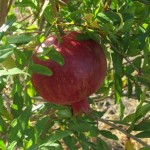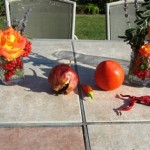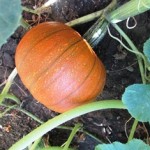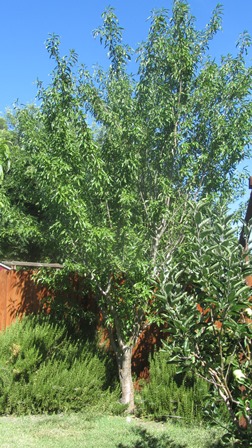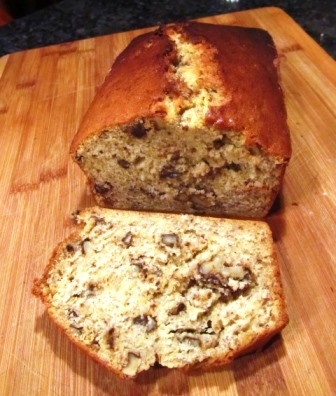Simple Gratitude for the Harvest
It’s nearly Thanksgiving and our Henny Penny Farmette continues to bring forth delicious, organically grown edibles for our table for which we feel truly grateful.
We give thanks, too, for neighbors like Dan and Annie. This past Sunday, Annie carted to our house a box of persimmons and bags of apples and pomegranates. We harvested all our apples last month so her timing was great. While we have persimmons and pomegranates hanging on the trees in our small orchard, many are not yet ripe enough to pick.
Last month, I froze cubes of butternut squash in freezer bags and readied pumpkin flesh for pie. While picking a few ripe persimmons recently, I noticed that we’re sharing them with a visitor who seems to sneak in and munch during the night. I’m thinking the culprit could be a raccoon, opossum, skunk, squirrel, fox, or a gaggle of wild turkeys that seem to make an annual pilgrimage through our area.
The two main types of persimmons grown on our farmette are Fuyu and Hachiya. The Fuyu is rather squat-looking and Hachiya has an elongated shape. Both take on a bright orange color in the fall. When fully ripe, Fuyu is sweet and crunchy like an apple whereas the Hachiya is soft like jelly. Though commonly thought of as fruits, persimmon and pomegranate are technically berries.
Fuyu persimmons can be peeled, sliced, and eaten fresh, roasted, or tossed into salads. They add a vibrant splash of orange to a winter salad that could include slices of citrus and pear tossed with greens,walnuts, pomegranate seeds, and goat cheese.
Pomegranates are ripe when their leathery outer covering turns red and begins to crack. Inside each pomegranate is white tissue separating compartments of ruby-red seeds called arils.
The seeds are high in antioxidants that reduce inflammation and free radical damage. Though they are messy to remove, the pomegranate seeds are healthy and nutritious additions to any diet.
To preserve pomegranate seeds, freeze them on a baking sheet. Once frozen, slip the seeds into freezer bags and return to the freezer. The seeds can be kept frozen for months.
Pumpkins come in a variety of sizes and types. Personally, I prefer the sugar pumpkins for recipes calling for pumpkin as an ingredient.
This week as we prepare for the big feasting day of Thanksgiving, lots of cooks are already baking pumpkin pies. Many will use canned pumpkin as a shortcut to their pie preparation but pumpkin filling made from scratch is especially delicious.
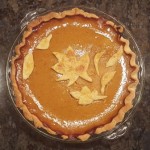
Our pumpkin pie features leaves of pie dough, brushed with egg, and sprinkled with sugar before baking
The old fashioned way to make pumpkin pie from scratch is to use fresh, organic pumpkin puree from the produce that you’ve grown in your garden. The process to make a pie takes longer because first the pumpkin must be peeled, seeded, and cut into manageable pieces and then cooked down. Then just follow your favorite pumpkin pie recipe.
_________________________________________________________________
Taking care of yourself is one of the most important things you can do over your lifetime and it starts with healthy ingredients and fresh produce.
My newest self-help wellness book is THE SELF-CARE PLANNER, A Weekly Guide to Prioritize You.
My books are available for purchase through online and traditional bookstores everywhere. Buy The Self-Care Planner and other titles offered by my publisher, Simon & Schuster online. Visit my author’s page at https://www.simonandschuster.com/authors/Meera-Lester/2137649823

It’s never too late to get healthy and live a richer, fuller, and more meaningful life. Self care is not selfish but rather an act of love.
YOU NEED THIS BOOK. WE ALL DO.
Buy it now from:
https://www.simonandschuster.com/books/The-Self-Care-Planner/Meera-Lester/9781507211649
Check out more recipes and tips for healthy country living in my Henny Penny Farmette series of cozy mysteries (Kensington Publishing, NY).
Warm Pomegranate Sauce Dressing Dazzles on Spinach Salad
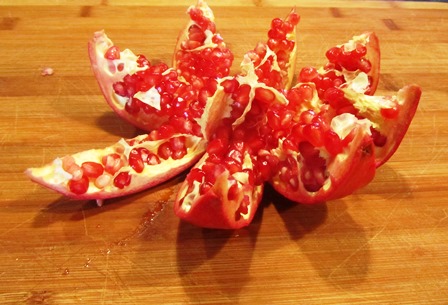
Pomegranate seeds add sweetness and crunch to salads but can eaten fresh, or you can extract the juice to make a lovely sauce.
Use fresh pomegranate juice if you would like a delicious sauce to use in salad dressing or other culinary creations. Pomegranate sauce made into a warm salad dressing dresses up a plain spinach salad like nothing else.
The warm pomegranate dressing is made by combining to blend 1/2 cup pomegranate sauce (recipe below), 1 Tablespoon of honey, 1 1/2 teaspoons minced fresh ginger, 1 cup California extra-virgin olive oil, and 1/2 cup coarsely chopped walnuts. Warm the dressing and pour over over a pound of freshly washed spinach leaves, 1/2 cup red onion, and 1 orange (peeled, seeded and with segments quartered).
Here’s how to make and preserve the pomegranate sauce.
INGREDIENTS:
5 cups of pomegranate juice (reamed from about 10 large fruits)
1/2 cup lemon juice
1 cup sugar
DIRECTIONS:
Wash thoroughly ten large pomegranates.
Cut in half and use a reamer to extract the juice from the seeds, discarding the membrane.
Strain the juice through cheesecloth several times to obtain 5 cups.
Combine the juice, lemon, and sugar in a large saucepan over medium-high heat.
Bring to a boil and then turn down the heat and simmer at 180 degrees Fahrenheit.
Reduce the sauce by half.
PROCESS:
Have ready 4 half-pint jam jars that have been washed on a hot cycle in the dishwasher and dried.
Fill the canner with water, place on heat, and bring to a simmer.
Simmer jar lids and rings.
Fill the jars with the pomegranate sauce, leaving 1/4 inch head space.
Affix hot lids to the jars and screw on the rings.
Lower the jars on the rack into the canner (water must cover the jars by at least an inch) and boil the water for 10 minutes.
Remove the jars of sauce and allow to cool.
Check seals, label, and then store until needed.
For more delicious recipes, farming tips, and beekeeping strategies as well as a cozy mystery, check out the first book in the Henny Penny Farmette series from Kensington Books in New York. Available on Amazon.com, Barnesandnoble.com, and in other online and traditional bookstores everywhere.

Northern California Nut Trees in a Nutshell
Take a trip into Northern California’s great Central Valley and you’ll notice how the landscape becomes dotted with nut tree farms along with vegetable fields, fruit tree orchards, and dairy farms. While Texas dominates the pecan tree market, California’s big three nut crops are almonds, walnuts, and pistachios. With nut prices on the increase, backyard gardeners might consider planting a tree or two if they have the space.
Some nut trees, such as almonds, require pollination assistance–a couple of different cultivars and honeybees will do the trick. For this reason, commercial almond growers pay beekeepers to bring their hives in to pollinate California’s early almond crop each year. Growing almonds is big business in California (it’s the third leading agricultural product in the state); the decline in honeybee populations is bound to affect this profitable crop.
The Central Valley has the perfect climate and growing conditions for almonds. It’s estimated that there are roughly 5,500 almond growers in the state. Many are commercial growers who capitalize on the rich, well-drained soil, and the hot summers and cool winters of Northern California. But California’s continuing drought is causing concern to almond growers since almonds require a lot of water. Backyard gardeners, too, must consider the water requirement of almonds before planting trees.
A newly formed almond on the tree looks like an unripe fuzzy peach because almonds are related to the peaches. Mature almond trees reach 20 to 30 feet tall. Some popular cultivars in zones 5 through 8 are Hall’s Hardy, Nonpareil, Peerless, and Mission. My neighbors have gorgeous, healthy almonds growing on their farmette.
The California Black Walnut and Persian Walnut (with cultivars of Franquette, Chandler, and Hartley) are valued for their stateliness, shade, bountiful crops, and longevity. Walnuts contain healthy nutrients. Cultivars of the English walnut are fast-growing and the nuts are thin-skinned and bountiful.
If a walnut is planted at the birth of an individual, and he lives 75 years, that walnut tree might could still be growing when the person breathes his last breath. The black walnut can reach 100 feet in height. The nuts have an thick outer hull that can blacken sidewalks and driveways with their stain; also, the tree also can be toxic to other plants.
In comparison to walnuts, filberts/hazelnuts are considered small trees (achieving heights of only 10 to 40 feet), they are often the nut tree of choice for backyard landscapes. DuChilly and Daviana are excellent pollinizers with Barcelona. Other cultivars are Bixby, Royal, and Hall’s Giant.
Pecan trees grow much larger than filberts, often towering 70 to 150 feet. Some cultivars include Major, Peruque, Stuart, and Colby. The cultivars of Wichita, Western Schley, and Cherokee are excellent pollinators for each other. Of all the nuts valued for their antioxidants, pecans rank the highest.
There is a pistachio tree growing a mile or so from my farmette. While pistachios love the Mediterranean climate of the Central Valley, in some places the trees perform better than in others. The nuts are highly valued by consumers. Growers have taken notice. Pioneer Gold, a varietal that’s been around since 1976, remains a popular choice. The trees are wind pollinated and require a male and female tree for a crop set.
If you have room in a backyard garden or on a farmette or field, consider planting one or more nut trees. You’ll be rewarded with shade and heart-healthy, nutritional snacks for years to come.
Traditional Banana-Walnut Bread
When the bananas on the kitchen counter become soft and the peels develop brown freckles, don’t toss them. Make a loaf of banana-walnut bread. This bread makes a lovely complement to a cup of steaming, fragrant Earl Grey tea.
The ingredient list for this bread is simple and the directions are easy. To start, you’ll need a 9 by 5-inch loaf pan, greased and floured; and, you’ll need to affix the paddle to your mixer. Set the oven to 350 degrees Fahrenheit. The recipe yields one loaf.
RECIPE: TRADITIONAL BANANA-WALNUT BREAD
Ingredients:
6 Tablespoons of softened, unsalted butter
1 cup sugar
1 1/2 cup mashed ripe bananas
3 large organic eggs
1/2 cup buttermilk (or 2 Tablespoons buttermilk powder dissolved in 1/2 cup warm water)
2 cups all-purpose flour
1 teaspoon baking powder
1 teaspoon baking soda
1 teaspoon ground nutmeg
1/2 teaspoon salt
1 cup walnuts, coarsely chopped
Directions:
Mix together in a large bowl the following–flour, baking powder, baking soda, nutmeg, salt, and chopped nuts. Set aside.
In the mixer bowl, cream the butter and sugar.
Add the bananas.
Add one egg at a time.
Add the buttermilk.
Pour the flour into the banana mixture and mix a little at time until the ingredients are all combined.
Fill the floured and greased loaf pan with batter until the pan is roughly 2/3 full.
Bake for approximately 55 minutes or until a toothpick inserted into the batter comes out clean.
*Tip: ripe bananas can be peeled and stored in a zip-lock freezer bag and frozen.
 Facebook
Facebook Goodreads
Goodreads LinkedIn
LinkedIn Meera Lester
Meera Lester Twitter
Twitter





